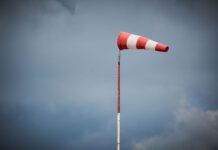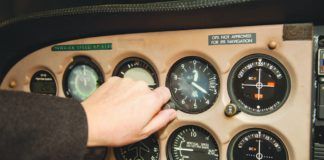Disregard that Glidepath
“Familiarity Traps” was a very good article (October 2011 IFR), and one that a lot of us should learn from to develop our SOPs.
I could make a strong argument to fly all approaches as published and not rely on anyone’s pseudo-glideslope, or advisory glideslope info, no matter what. And, as you clearly point out, the advisory GS could catch pilots with their pants down and cause some grief.
If you look at this approach and brief it just as it is, you would properly brief the “dive and drive” from over LOTMY down to 2040 feet and not go an inch lower until the runway environment was in sight. Also, you could clearly see the reason for the high mins by noting that obstruction of 1780 feet just short of the runway.
This approach could easily be briefed for a straight-in; however, I’d reserve the option for a circle (but would descend to the circling mins). For a lot of our GA planes, we could easily do a six-degree descent (we can with the Beechcraft). So you would brief seeing the airport at 1.7 miles for the straight in, and if you were willing to land on the last half, could descend at the 1.4 point. That’s perfectly legal and safe—if you’ve been trained and your plane has the performance.
Keep up the good work.
Larry Olson
St. Petersburg, Fla.
Chronicles of NORDO
Reading November’s Readback section, the “NORDO? Dial 911” reminded me that I have direct experience in calling a tower on my cell phone, but maybe not in the manner the reader was thinking.
About seven years back, a local non-federal tower was experiencing radio transmission and receiving challenges. It was definitely a problem.
I was flying into the airport for some scheduled maintenance, and flight conditions were good VFR where I was. However the conditions close to the Class D were not, and I called the Tower several times requesting a Special VFR. However, the Tower was not responding to my calls.
As I circled outside of their airspace, I decided to call the Tower on my cell phone. They answered the call. I told them I had been attempting to contact them on the radio. I told them where I was, and that I was requesting a Special VFR.
The controller hesitated for a second, then granted me the request with his own request to contact him on the radio as soon as possible. The controller (I think still puzzled and surprised by my call) commented that he was not sure he would allow this the next time I called from a cell phone. The approach to the airport and landing all worked out fine.
Charlie Hoover
Winter Haven, Fla.
Back in the ’70s, before there were cell phones, I owned a local truck line and there was a radio company that would answer our radio calls and plug us into the telephone system at our request.
One day after departing Yakima, Wash., the microphone in the aircraft that I was instructing in quit. I had just cleared the overcast cloud deck over the city and the airport on my departure. I was able to hear the Tower calling me, but the new microphone wasn’t working.
As they tried to call me several times, I circled back over the city and located a hole in the clouds over a sawmill. I called the radio company on my hand-held, business-frequency portable, and asked them to dial up Yakima Tower and patch me through. They did. When the fellow in the Tower answered the telephone, I gave him my aircraft number, my location, and requested a clearance to land. I got an immediate clearance and heard a couple of aircraft given instructions to go-around and circle west of the airport while I descended through the hole and landed VFR.
Another time when I was approaching Spokane International in VFR weather, the radios quit on the Cherokee I was flying, so I called up the radio company in Spokane and had them phone-patch me to the Spokane Tower and after a few startled moments the Tower Controller gave me clearance to land.
All you need these days is the telephone number of the Tower or 800-WX -BRIEF and a cell phone. Good Luck.
Lynn Buchanan
Yakima, Wash.
Step One: Engage Brain
No one could have stated the issue better (than your November 2011 Remarks, “It’s About Engagement”).
My IFR training at Van Nuys in 1970 was in a C-150 with a standard six-pack, one navcomm, an ADF and no transponder. And that’s what I used for the practical test. I think about my instructor in those days having me set up holds at the intersection of radials from two VORs, and checking for intersections along an ILS or localizer approach. It’s a wonder students did not twist the knobs off the nav portion and the OBS.
It’s hard now to imagine being any more connected and engaged than under those conditions. We were really being taught to keep a moving map in our heads. Later when joining a flying club I was stunned to learn they had airplanes with dual navcomm sets. What opulence!
Ron Brusha
Glendale, Calif.
Hope on the Horizon?
Has the issue of Jeppesen not having a Macintosh-based NavData card loader hit anyone’s radar?
I am also wondering if there’s any relief in sight for IFR routing in the northeast, specifically the elimination of the 60-mile buffer, no-fly zone around the NYC Bravo? I know, I know, I’m just the cranky guy who hates adding 50-100 miles to his trips anywhere south of LGA/JFK, EWR, PHL, BWI, DCA/IAD; and who thinks GA guys get the worse, lowest ATC service.
It’s my opinion that AOPA has been less than helpful in representing our (GA’s) interests in the process.
I have heard that New York Approach is not accepting VFR advisory service handoffs from other adjoining sectors; they’re always too busy. Even other controllers from adjoining facilities say these folks are unhelpful.
Steve Schunk
San Antonio, Texas
The lack of a Mac or Browser-based platform is an old problem. Jeppesen tells us there is a Mac version in development, but with no release date set yet. There are no plans for a platform-independent version that runs in a web browser.
As for N.Y. Approach, we’ve had mixed luck with VFR handoffs, but have not had trouble picking up VFR flight following or reasonable routes … most of the time. If you try and cross the airspace on the west side, you’re going to do it via Pennsylvania (Lake Henry VOR). But if you can accept 5000 over JFK or top the Bravo over 7000, it’s usually a non-issue VFR.
Don’t Wanna Hold
I love your videos on tips and tricks for the Garmin 430. I just viewed the approach video that shows when vectors to final could cause a problem. My version of the Garmin 400W trainer does not support the trick you used, which was activating a leg on the approach while getting vectors.
I think that I may be able to use that trick for a recent situation, which has developed when they changed some approaches at my home airport, Farmingdale, N.Y. But I cannot check it out as my trainer does not let me select “activate leg” on an approach.
Here is the problem. The old GPS 19 approach was a classic T approach, from PODAL to DEBYE, then inbound on final via MOIRE, the FAF. That was easy.
Now, they have eliminated PODAL, made DEBYE an IF/IAF, and incorporated a hold-in-lieu-of-procedure-turn at DEBYE. This would be fine but, without fail, ATC vectors me to the vicinity of where PODAL was, says to proceed direct DEBYE, and clears me for the GPS 19 approach. When I activate the approach, the 430 wants me to fly the hold, but ATC does not.
Can I use the same procedure as you showed in the video where, when going direct DEBYE I can activate the leg from the hold to DEBYE? A video demonstrating how to do this would be great.
David Tobachnik
Coram, N.Y.
We don’t have a video to point you to, but John Ewing’s article on page nine of this issue could help. It shows how to simply remove that hold from your flight plan. You could activate the leg after the hold, as you suggest. That would also work.
Have a comment, compliment, critique or call to arms? Share your thoughts via [email protected]. Note the new email address.




